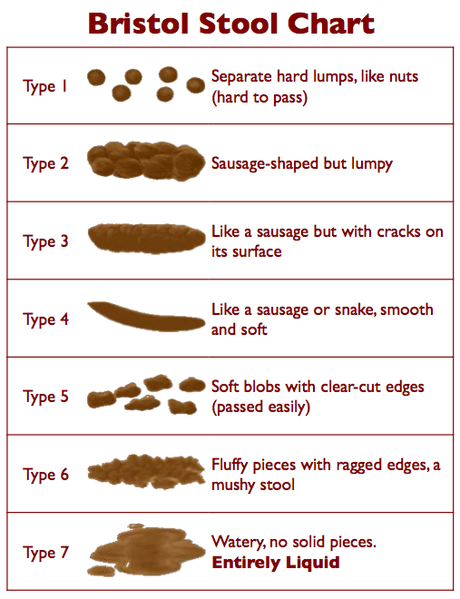Difference between revisions of "Human Feces"
| (One intermediate revision by the same user not shown) | |||
| Line 1: | Line 1: | ||
| − | [http://en.wikipedia.org/wiki/ | + | [[Image:460px-Bristol Stool Chart.png|right|So useful!!]] |
| + | [http://en.wikipedia.org/wiki/Human_feces The Original Article] - now updated with the exciting [http://en.wikipedia.org/wiki/Bristol_Stool_Scale Bristol Stool Scale] - KIM MUST READ!! | ||
''Human fecal matter varies significantly in appearance, depending on diet and health. Normally it is semisolid, with a mucus coating. Its brown colouration comes from a combination of bile and dead red blood cells. In newborn babies, fecal matter is initially yellow/green after the meconium. This colouration comes from the presence of bile alone. In time, as the body starts expelling excess dead red blood cells, it acquires its familiar brown appearance, unless the baby is breast feeding, in which case it remains soft, pale yellowish, and not-unpleasantly scented until the baby begins to eat significant amounts of other food. Throughout the life of an ordinary human, one may experience many types of feces. A "green" and sometimes "clay-like" appearance to the feces is a result in a lack of blood cells expelled. Bile overload is very rare, and not a health threat. Problems as simple as serious diarrhea can cause blood in one's stool, turning it black. Food may sometimes make an appearance in the feces. Common undigested foods found in human feces are seeds, nuts, corn, and beans, mainly because of their high fiber content.'' | ''Human fecal matter varies significantly in appearance, depending on diet and health. Normally it is semisolid, with a mucus coating. Its brown colouration comes from a combination of bile and dead red blood cells. In newborn babies, fecal matter is initially yellow/green after the meconium. This colouration comes from the presence of bile alone. In time, as the body starts expelling excess dead red blood cells, it acquires its familiar brown appearance, unless the baby is breast feeding, in which case it remains soft, pale yellowish, and not-unpleasantly scented until the baby begins to eat significant amounts of other food. Throughout the life of an ordinary human, one may experience many types of feces. A "green" and sometimes "clay-like" appearance to the feces is a result in a lack of blood cells expelled. Bile overload is very rare, and not a health threat. Problems as simple as serious diarrhea can cause blood in one's stool, turning it black. Food may sometimes make an appearance in the feces. Common undigested foods found in human feces are seeds, nuts, corn, and beans, mainly because of their high fiber content.'' | ||
Latest revision as of 12:26, 23 March 2009
The Original Article - now updated with the exciting Bristol Stool Scale - KIM MUST READ!!
Human fecal matter varies significantly in appearance, depending on diet and health. Normally it is semisolid, with a mucus coating. Its brown colouration comes from a combination of bile and dead red blood cells. In newborn babies, fecal matter is initially yellow/green after the meconium. This colouration comes from the presence of bile alone. In time, as the body starts expelling excess dead red blood cells, it acquires its familiar brown appearance, unless the baby is breast feeding, in which case it remains soft, pale yellowish, and not-unpleasantly scented until the baby begins to eat significant amounts of other food. Throughout the life of an ordinary human, one may experience many types of feces. A "green" and sometimes "clay-like" appearance to the feces is a result in a lack of blood cells expelled. Bile overload is very rare, and not a health threat. Problems as simple as serious diarrhea can cause blood in one's stool, turning it black. Food may sometimes make an appearance in the feces. Common undigested foods found in human feces are seeds, nuts, corn, and beans, mainly because of their high fiber content.
I totally never knew that. Bile and dead red blood cells- creating the distinctive color! Also:
The distinctive odor of feces is due to bacterial action. Bacteria produce compounds such as indole, skatole, and thiols (sulfur containing compounds), as well as the inorganic gas hydrogen sulfide. These are the same compounds that are responsible for the odor of flatulence. Consumption of foods with spices may result in the spices being undigested and adding to the odor of feces. Certain commercial products exist that can reduce the odor of feces.
Wikipedia is so useful. It also links to Doggy Poo from the poop article.
